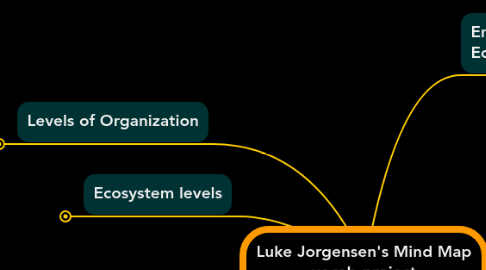
1. Biotic factors
1.1. Biotic factors are the factors in a biome/ecosystem/habitat that include all living things.
2. Levels of Organization
2.1. Organism
2.1.1. Any form of life
2.2. Population
2.2.1. Group of individuals of the same species found in a given are or located in the same area at a given time
2.3. Community
2.3.1. Populations of living organisms that interact with one another in an ecosytem
2.4. Ecosystem
2.4.1. group of living organisms that interact with one another and the nonliving physical environment and as one unit
2.5. Biomes
2.5.1. Rainforest
2.5.2. Desert
2.5.3. Grassland/savannah
2.5.4. Tundra
2.5.5. Freshwater Biome
2.5.6. Marine Biome
2.5.7. Coniferous Forest
2.5.7.1. Pinecones
2.5.8. Temperate Deciduous Forest
2.5.8.1. Pa
2.6. Biosphere
2.6.1. layer of soil,water,and air that sustains life
2.6.2. Earth
3. Abiotic Factors
3.1. abiotic components are non-living chemical and physical factors in the environment.
4. Ecosystem levels
4.1. Ecological succession
4.1.1. the gradual and orderly process of change in an ecosystem brought about by the progressive replacement of one community by another until a stable climax is established
4.2. Primary Succession
4.2.1. Succession that occurs on surfaces where no soil exists. Ex. After volcanic eruptions
4.3. Secondary succession
4.3.1. the process of revegetation of an area that has been cleared for some reason
4.4. Pioneer species
4.4.1. The first species to live in an area
4.5. Climax Community
4.5.1. when a area is at its peak of evolution
4.6. Limiting factors
4.6.1. Factors that limit and control the population of an ecosystem
4.7. Carrying Capacity
4.7.1. How much a ecosytem can hold(population)
5. Population
5.1. population growth rate
5.1.1. The rate a population grows
5.2. Population growth
5.2.1. increase in the number of people who inhabit a territory or state
5.3. Sustainability
5.3.1. the ability to sustain life
5.4. Black Plague
5.4.1. Black Death: the epidemic form of bubonic plague experienced during the Middle Ages when it killed nearly half the people of western Europe.
5.5. Industrial Revolution
5.5.1. A rapid major change in an economy marked by the general introduction of power-driven machinery or by an important change in the prevailing types and methods of use of such machines.
5.6. J-curve
5.6.1. a graph representing exponential population growth.
5.7. Exponetial Growth
5.7.1. Growth whose rate becomes ever more rapid in proportion to the growing total number or size
5.8. Logistic Growth
5.8.1. Growth rates regulated by internal and external factors that establish an equilibrium with environmental resources
5.9. S-curve
5.9.1. A curve that the rate of growth is rapid and then the growth rate declines
6. Energy Transfer in Ecosytems
6.1. Food Chain
6.1.1. Sun
6.1.1.1. Grass
6.1.1.1.1. Cow
6.2. Food Web
6.2.1. Sun
6.2.1.1. Grass
6.2.1.1.1. Cow
6.2.1.1.2. Bird
6.3. Trophic Levels
6.3.1. Producer
6.3.1.1. Primary Consumer
6.3.1.1.1. Secondary Consumer
7. Environment
7.1. BioDiversity
7.1.1. Hotspots
7.2. Aquifer
7.2.1. A body of permeable rock that can contain or transmit groundwater.
8. Pollution
8.1. water pollution
8.1.1. pollution of the water in rivers and lakes
8.2. point source
8.2.1. A point source of pollution is a single identifiable localized source of air, water, thermal, noise or light pollution.
8.3. Non-Point source
8.3.1. pollution that occurs when rainfall, snowmelt, or irrigation runs over land or through the ground, picks up pollutants, and deposits them into rivers, lakes, and coastal waters or introduces them into ground water.
